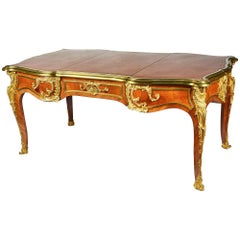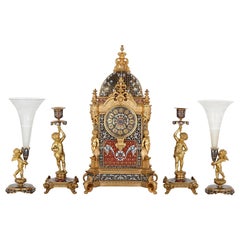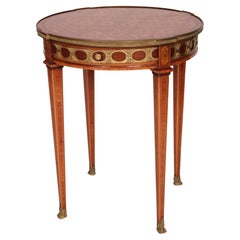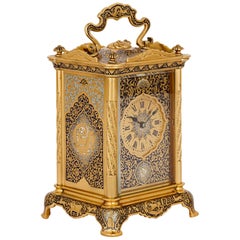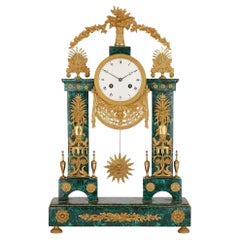Ormolu Furniture
19th Century French Louis XV Antique Ormolu Furniture
Ormolu
Late 19th Century French Antique Ormolu Furniture
Ormolu, Bronze, Enamel
Early 19th Century French Empire Antique Ormolu Furniture
Carrara Marble, Ormolu
1920s French Louis XVI Vintage Ormolu Furniture
Ormolu
19th Century French Belle Époque Antique Ormolu Furniture
Enamel, Ormolu, Bronze
Late 18th Century French Louis XVI Antique Ormolu Furniture
Malachite, Ormolu
1870s French Empire Antique Ormolu Furniture
Crystal, Bronze, Ormolu
19th Century Austrian Greek Revival Antique Ormolu Furniture
Ormolu
19th Century European Egyptian Revival Antique Ormolu Furniture
Onyx, Bronze, Ormolu
19th Century French Louis XV Antique Ormolu Furniture
Ormolu
Mid-19th Century French Louis XV Antique Ormolu Furniture
Ormolu
Late 19th Century French Neoclassical Antique Ormolu Furniture
Onyx, Ormolu, Bronze, Enamel
Early 1900s French Louis XV Antique Ormolu Furniture
Bronze, Ormolu
19th Century American Federal Antique Ormolu Furniture
Brass, Ormolu
Late 19th Century French Neoclassical Antique Ormolu Furniture
Ormolu, Bronze
Late 19th Century French Louis XVI Antique Ormolu Furniture
Ormolu
1880s French Louis XV Antique Ormolu Furniture
Ormolu
Late 20th Century Italian Empire Ormolu Furniture
Ormolu
19th Century French Louis XVI Antique Ormolu Furniture
Crystal, Ormolu
21st Century and Contemporary German Post-Modern Ormolu Furniture
Brass, Ormolu
19th Century French Empire Antique Ormolu Furniture
Marble, Ormolu
19th Century French Rococo Antique Ormolu Furniture
Ormolu
Late 19th Century French Rococo Antique Ormolu Furniture
Ormolu
19th Century French Louis XVI Antique Ormolu Furniture
Ormolu
19th Century French Louis XV Antique Ormolu Furniture
Crystal, Ormolu
19th Century French Louis XVI Antique Ormolu Furniture
Marble, Ormolu
19th Century French Louis XVI Antique Ormolu Furniture
Crystal, Ormolu
19th Century French Belle Époque Antique Ormolu Furniture
Ormolu
19th Century German Rococo Antique Ormolu Furniture
Ormolu
Late 19th Century French Antique Ormolu Furniture
Siena Marble, Bronze, Ormolu
19th Century French Louis XIV Antique Ormolu Furniture
Ormolu
1880s French Louis XVI Antique Ormolu Furniture
Ormolu
19th Century French Louis XVI Antique Ormolu Furniture
Ormolu
19th Century French Louis XVI Antique Ormolu Furniture
Ormolu
20th Century French Empire Ormolu Furniture
Malachite, Ormolu, Bronze
1870s Revival Antique Ormolu Furniture
Ormolu
19th Century French Louis XVI Antique Ormolu Furniture
Crystal, Ormolu
19th Century French Victorian Antique Ormolu Furniture
Enamel, Ormolu
1870s French Victorian Antique Ormolu Furniture
Ormolu
Late 19th Century French Neoclassical Antique Ormolu Furniture
Malachite, Ormolu, Bronze
Late 19th Century French Antique Ormolu Furniture
Ormolu
19th Century French Louis XVI Antique Ormolu Furniture
Ormolu
1830s British Regency Antique Ormolu Furniture
Ormolu
19th Century French Louis XVI Antique Ormolu Furniture
Crystal, Metal, Enamel, Ormolu
19th Century French Rococo Antique Ormolu Furniture
Ormolu
19th Century French Louis XVI Antique Ormolu Furniture
Marble, Ormolu
19th Century French Louis XVI Antique Ormolu Furniture
Marble, Ormolu
19th Century French Louis XVI Antique Ormolu Furniture
Marble, Ormolu
1810s French Empire Antique Ormolu Furniture
Ormolu
Late 19th Century French Rococo Antique Ormolu Furniture
Ormolu
19th Century Italian Neoclassical Antique Ormolu Furniture
Ormolu
19th Century Italian Antique Ormolu Furniture
Bronze, Ormolu
19th Century French Louis XVI Antique Ormolu Furniture
Ormolu
19th Century French Louis XVI Antique Ormolu Furniture
Ormolu
19th Century French Antique Ormolu Furniture
Ormolu, Bronze, Enamel
19th Century French Louis XVI Antique Ormolu Furniture
Griotte Marble, Enamel, Ormolu
19th Century Unknown Louis XV Antique Ormolu Furniture
Ormolu
Early 19th Century Russian Neoclassical Antique Ormolu Furniture
Ormolu
19th Century French Louis XVI Antique Ormolu Furniture
Ormolu
Mid-19th Century French Rococo Revival Antique Ormolu Furniture
Ormolu
Antique Ormolu Clocks, Lamps and Other Furniture and Decorative Objects for Sale
Antique ormolu furniture and decorative objects can be incorporated into a variety of spaces, and while demand for the material and/or technique was at its peak in Europe during the 18th and 19th centuries, ormolu is still widely loved by designers and collectors today.
What is ormolu?
Ormolu is a brilliant form of decorative trickery. To the untrained eye, ormolu clocks, jewelry boxes and other ormolu furniture and decor look like they're made of solid gold. But those in the know recognize ormolu — or elaborate bronze gilding — as having been essential to French design in the 18th and 19th centuries as a cornerstone of the neoclassical and Empire styles.
“Most commonly, ormolu refers to a bronze object that has been covered with gold, typically 18 karat or 24 karat,” explains Jamie Sinai, director of the antiques specialist Mayfair Gallery, in London. “For that reason, ormolu is sometimes called gilt bronze or, in French, bronze doré. Strictly speaking, however, the term ormolu also denotes the technique of applying gold to a metal.”
“The word comes from the French or moulu, which translates as ‘ground or powdered gold’ — the form the gold takes before it is applied to a metal surface.”
From the court of King Louis XVI to that of Napoleon I, the French elite snapped up furniture mounted with ormolu, as well as sconces, candelabra and table lamps made from the material. “As the French reputation for supreme art, architecture and furniture developed, the craze for ormolu spread across Europe,” adds Sinai.
Today, antiques collectors and interior designers continue to prize ormolu for its extraordinary craftsmanship and history-infused glamour.
“This wondrous material was highly sought after in France as the ultimate luxury. It magically resembled solid gold and sparkled under candlelight,” says Sinai.
Find antique ormolu furniture and decorative objects on 1stDibs.
